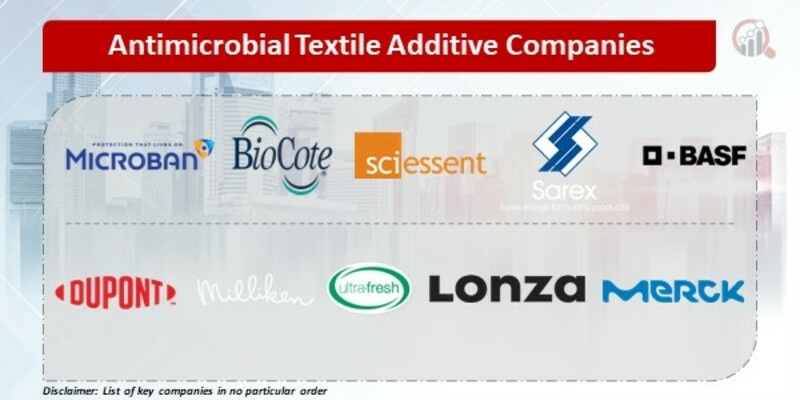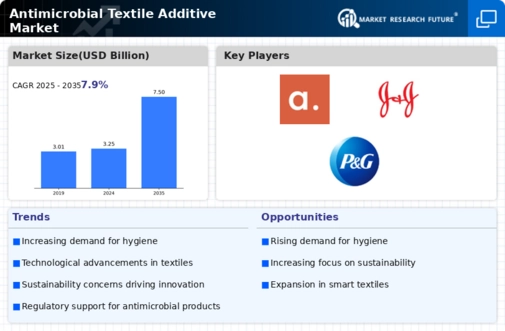Top Industry Leaders in the Antimicrobial Textile Additive Market
 The global antimicrobial textile additive market is witnessing robust growth, driven by rising demands for hygiene and odor control in diverse applications. This growth is fueled by increasing awareness about hygiene, particularly in healthcare and sportswear industries, combined with growing disposable income and expanding urbanization.
The global antimicrobial textile additive market is witnessing robust growth, driven by rising demands for hygiene and odor control in diverse applications. This growth is fueled by increasing awareness about hygiene, particularly in healthcare and sportswear industries, combined with growing disposable income and expanding urbanization.
Major Players and Strategies:
The competitive landscape of the antimicrobial textile additive market is moderately fragmented, with several established and emerging players vying for market share. Leading players include:
-
BASF SE: Offers a broad range of silver-based and triclosan-free additives like Ultra-Fresh and Polygiene. Focuses on innovation and partnerships to expand its product portfolio and geographical reach. -
DowDuPont: Provides diverse antimicrobial solutions under the X-pert brand, catering to various end-use applications. Invests heavily in research and development to strengthen its technological edge. -
Sanitized AG: Renowned for its Sanitized® hygiene function, offering long-lasting odor control and freshness. Emphasizes product sustainability and regulatory compliance to attract environmentally conscious customers. -
Microban International: Pioneered the use of triclosan-free technologies like Microban® 28 for antimicrobial protection. Employs strategic marketing and collaborations to drive brand awareness and market penetration. -
Sciessent LLC: Delivers innovative silver-based solutions like Silvadur® for durable odor control and antimicrobial performance. Maintains a strong focus on technical expertise and customer service to differentiate its offerings.
Strategies for Market Share:
Key strategies adopted by players in the antimicrobial textile additive market include:
-
Product diversification: Expanding product portfolios to cater to various end-use applications, fabric types, and desired functionalities. -
Technological advancements: Investing in research and development to create more effective, durable, and sustainable antimicrobial technologies. -
Strategic partnerships: Collaborating with textile manufacturers, brands, and research institutions to enhance product development and market reach. -
Geographical expansion: Entering new markets, particularly in developing regions with growing hygiene awareness and disposable income. -
Sustainability initiatives: Developing eco-friendly antimicrobial solutions that comply with stringent environmental regulations. -
Focus on regulatory compliance: Ensuring adherence to international safety and efficacy standards to gain customer trust and market access.
Factors Influencing Market Share:
Several factors influence market share in the antimicrobial textile additive market:
-
Product efficacy and durability: The effectiveness and duration of antimicrobial protection offered by the additive. -
Cost-effectiveness: The balance between price and performance, considering the value proposition for both manufacturers and consumers. -
Sustainability: The environmental impact of the additive and its compliance with eco-friendly standards. -
Brand reputation and trust: The reliability and reputation of the additive manufacturer and its commitment to quality and safety. -
Regulatory compliance: Adherence to relevant regulations and certifications for different end-use applications. -
Marketing and sales strategies: The effectiveness of marketing campaigns and sales channels in reaching target customers.
Key Players
- BASF SE (Germany)—IRGAGUARD
- Sanitized AG (Switzerland)—Sanitized
- Merck KGaA (Germany)—Irgasan
- Lonza (Switzerland)—Cosmocil CQ
- Thomson Research Associates, Inc (Canada)—Ultra fresh
- Milliken & Company (US)—AlphaSan
- DuPont (US)—SILVADUR
- Sarex (India)—Saraguard 5700
- Sciessent (US)—Agion
- BioCote Limited (UK)—BioCote
- Microban International (US)—AEGIS, Microban
- F Group Nano (US)—SmartSilver
Recent Developments
-
October 2023: Sanitized AG introduces Sanitized® Hygiene Function Freshness with enhanced odor management properties. -
November 2023: DowDuPont unveils X-pert Shield+, a next-generation antimicrobial additive offering improved durability and wash resistance. -
December 2023: Sciessent LLC expands its Silvadur® portfolio with a new silver-based additive specifically designed for medical textiles.










